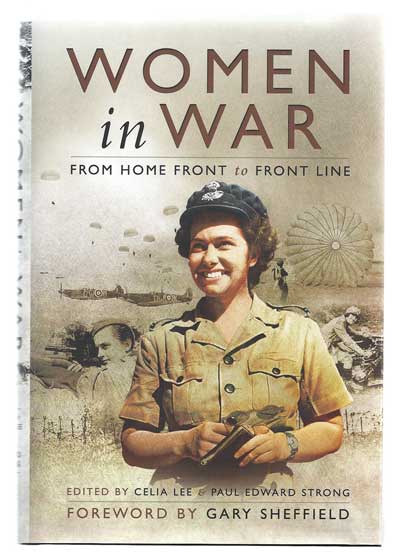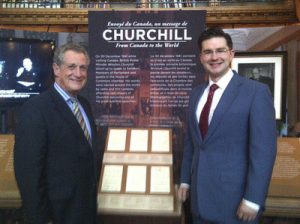
Bulletin #48 - Jun 2012
Churchill the Wartime Feminist

June 3, 2012
Historian Andrew Roberts considers Churchill’s feminist views on the occasion of the publication of “Women in War.”
By Andrew Roberts
In the battle of the sexes, Winston Churchill is often thought of as a male chauvinist pig due to his stalwart opposition to Votes for Women while Home Secretary in the Edwardian period. His public meetings were interrupted by suffragettes and a supporter of female enfranchisement even attacked him with a whip on a train. Despite his having voted for female enfranchisement in 1917, his reputation is sullied.
Yet a well-researched, well-written and fascinating new book, ‘Women in War: From the Home Front to the Front Line’, edited by Celia Lee and Paul Edward Strong, shows how by the time of the Second World War, Churchill had embraced sexual equality with fervour. Lee and Strong, who run a Women in War group in the British Commission for Military History, have identified a series of areas in which Churchill personally promoted the concept of women undertaking tasks that had hitherto solely been done by men, thus freeing up British males for frontline combat.
Follow this link for a short excerpt of Women in War, by Celia Lee and Paul Edward Strong.

2025 International Churchill Conference
The first ever female regiment to be formed in the British Army was the 93rd Searchlight Regiment of the Royal Artillery. Searchlights were crucial in wartime; often located on the beaches they spotlit German bombers so that the men operating the guns could shoot them down before they dropped their lethal loads on British towns. From 1935, a plan had been approved that nearly 100 searchlight companies would be required, comprising 2,334 lights, 3,000 Lewis guns, 464 three-inch guns and 43,500 men.
As Major Imogen Corrigan points out in ‘Women in War’, women were not initially allowed to take part in operating searchlights. It took Churchill to be far sighted enough to give his approval in September 1941 for the women to go into action. The use of the female regiment was the brainchild of Major-General Sir Frederick Pile, who later wrote: ‘The girls lived like men, fought their lights like men and, alas, some of them died like men.’
General Pile remained as Commander-in-Chief from 1939 until the work of AA Command and Britain’s air defence requirements could finally be closed down in April 1945. Defence writer Georgina Natzio points out how Pile was unusual during the Second World War for his endurance and staying power, assisted by the fact that he and Churchill shared a highly creative and questing outlook in the way they looked at war-related, social and technical matters. It is clear from Pile’s memoir, Ack-Ack, that they understood each other as individuals. Even though Pile was not popular amongst his contemporaries, Churchill – who had more than once known that problem himself – had the wisdom not to move him, because he recognised that Pile was a gifted leader who had welded together a strong sense of identity and purpose among the thousands who served in AA Command.
Similarly, the Women’s Royal Naval Service (WRNS) had been created to free up men for technical and combat roles that could be carried out by women. It was as First Lord of the Admiralty that Churchill wrote to Princess Marina, Duchess of Kent on 23rd February 1940, asking her to accept an honorary appointment as Commandant. Marina’s role was to tour England, Scotland and Wales, inspecting the WRNS working and living quarters and boosting morale. Women and girls undertook duties which involved secretarial, cypher, code, clerk, accountant, shorthand-typist, telephone operator, or signalling work. There were also transport vehicle drivers, and general duties, which were mainly of a domestic nature such as cooks, stewardesses and waitresses. As Celia Lee writes in the chapter on the WRNS, following a radio broadcast appeal by the Princess on 20 January 1941, the work of Service was extended to radio and air mechanics, maintenance, torpedo and boats’ crews, radar detection finders, cinema operators, gunnery dome operators, submarine attack teacher operators, meteorologists, bomb range markers, vision testers, cine gun assessors, and anti-aircraft target operators.
Princess Marina reported directly and in person on the work of the WRNS to Churchill at No. 10 Downing Street.
Dr Juliette Pattinson writes of how women were recruited in significant numbers by the Special Operations Executive (SOE), which was established in July 1940, following the invasion of much of Europe and the evacuation of the British Expeditionary Force from Dunkirk. There was a recognition that the rules of war had changed and that the only way to defeat Nazism was to engage in unorthodox warfare. Acts of sabotage and subversion, which were given increased prominence in Churchill’s war strategy, were perceived as a ‘fourth arm’ in addition to the established military services. Churchill ensured that the SOE was fully incorporated into plans to liberate Europe and received substantial funds to undertake its work.
The First Aid Nursing Yeomanry (FANYs), written about by Jonathan Walker, provided women as well as men to engage in secret operations of espionage against the Germans also met with Churchill’s approval. As part of the Special Operations Executive (SOE) women like Sue Ryder took on the role of confidants and counsellors to SOE’s agents, particularly those in the Polish Section. Dr Pattinson relates how Jos Mulder Gemmeke, a British-trained Dutch national, was a courier in the Dutch resistance. Jos recalled how she would often place weapons or a wireless set in her bicycle basket concealing them with food, flowers or knitting.
Women also worked in secrecy at RAF Medmenham, the Central Intelligence headquarters for Photographic Intelligence (PI). Christine Halsall’s chapter explains how they interpreted the aerial photographs brought back by pilots from Germany and the occupied territories. When new photographs were compared with older ones of the same areas it became apparent if the Germans were developing weapons or other facilities. These could therefore become targets for Bomber Command.
Churchill’s daughter Sarah Oliver had served as an aircraftswoman plotter for six months before training as a PI. She was posted to RAF Medmenham where her responsibility was to keep a daily watch on Kiel Harbour to identify the German vessels in port and monitor their movements. In the summer of 1942, with the buildup to the North African landings underway, Sarah transferred to this inter-Allied, inter-Service team, and worked intensely for several months on preparations for the top-secret invasion of North-west Africa, ‘Operation Torch’.
The code-breaking centre at Bletchley Park near Milton Keynes came under the auspices of MI6. There, the German encoding machines, Enigma and Lorenz, were used to decode German Morse code enabling the Allies to read vast amounts of material that the Germans always thought was perfectly secure. John Lee shows how the majority of people employed there were women and at least 6,600 of them made a direct contribution to the daily deciphering of enemy messages. Churchill received a daily synopsis of important intelligence from Station X at Bletchley Park. The most vital work of all was the ability to read the German naval messages that revealed where the submarine ‘wolf packs’ were lurking during the battle of the Atlantic. Winston Churchill’s greatest fear was that the sinking of Allied shipping by the U-boats would starve Britain into submission and cost her the war. That this never happened was largely due to the work undertaken by the women decrypters at Bletchley. The crucial sinking of the Bismarck was also made possible by Bletchley.
The problems of illness and disease plagued the soldiers of both world wars. Thousands of soldiers died, particularly in the First World War, who could have been saved by antibiotics. In 1915, Churchill had been responsible for planning the ill-fated Gallipoli campaign where nearly 500,000 Allied troops were lost through injury or illness rather than as a direct result of enemy action. Yet as early as November 1914, Professor Dr F.W. Twort FRS, a distinguished British scientist, had advised the Royal Army Medical College that dysentery was going to be a major problem. In a learned paper, Twort mentioned a possible cure for dysentery but was ignored. In a fascinating chapter of this book, Grace Filby writes: ‘If only Churchill had known about Twort’s perceptive observations through a microscope, it might have saved his humiliating loss of office in the First World War,’ for Twort had discovered some ‘ultramicroscopic’ bacteria-eaters, which later became known as ‘bacteriophage’.
Victory over bacterial infections finally came into sight after the First World War with Sir Alexander Fleming’s discovery of penicillin in 1928. Between 1941 and 1947, Clementine Churchill led up a massive fundraising effort, the Red Cross ‘Aid to Russia’ Fund, which enabled £7.5 million-worth of medical supplies and equipment to be sent from the west to help the Soviet Union. The Churchill family knew at first hand the devastation caused by illness and disease in the days before antibiotics. Churchill’s father, Lord Randolph, died in 1895 of what is now considered to have been an inoperable brain tumour. His nanny Elizabeth Everest died of peritonitis. In 1921, his mother Jennie contracted gangrene and died after her leg was amputated. His daughter Marigold died aged 2½ of septicaemia that developed out of a throat infection at a time when there was no known antibiotic to save her.
Grace Filby’s concern over this recurring theme of bacterial infections and the need to combat them took her to the Republic of Georgia as a Winston Churchill Travelling Fellow in 2007, researching the health value of bacteriophages. There she found a team of women whose scientific programme prevents and treats harmful bacteria and who work for the advancement of microbiology in the former USSR.
Winston Churchill’s granddaughter-in-law, Mary (Minnie) Churchill, gave the address at the Air Transport Auxiliary Association’s (ATA’s) Annual Dinner in 2002, at RAF Lyneham. Present was the Second World War veteran ATA aviatrix, Diana Barnato-Walker, now aged 84. In 1963, Diana was the first British woman to break the sound barrier, flying one of the RAF’s new supersonic Lightnings. During the war the ATA was staffed by men and women pilots who ferried aircraft to the male RAF pilots who went into action over the skies of Britain, fighting the German Luftwaffe. Paying tribute to the women who served in the ATA, Minnie referred to her father Commodore, Sir Gerard d’Erlanger CBE, a director of British Airways, who had suggested the formation of an aircraft-ferrying service before the outbreak of the war.
Minnie in her chapter refers to the events of the day of infamy: ‘Sunday evening – December 7, 1941, Winston hears of the attack on Pearl Harbour; within moments, he talks to President Roosevelt, who confirms the attack. Winston immediately, and within the hour, declares war on Japan. His feelings are expressed so well in his words: ‘No American will think it wrong of me if I proclaim that to have the United States at our side was to me the greatest joy. Up to the neck and in to the death. So we had won after all.’ That night, in Winston’s own words, he went to bed and ‘slept the sleep of the saved and thankful.’
One of the foremost reasons why ‘we had won after all’ was the way in which Great Britain, the United States and the Soviet Union mobilized their entire populations for the Total War that the Fascist powers unleashed on Civilization. Paul Edward Strong shows how by total contrast, the Nazis put their ‘home and hearth’ sexist ideologies foremost, and failed to use the female half of their populations to anything like the degree they could have. So, far from being a male chauvinist, Winston Churchill should be seen in his proper light, as a doughty proponent of sexual equality so long as there was a war to win.
Dr Andrew Roberts kindly contributed this piece for Chartwell Bulletin and is a regular contributor to Finest Hour. Roberts, born in 1963, took a first class honours degree in Modern History at Gonville & Caius College, Cambridge, from where he is an honorary senior scholar and a Doctor of Philosophy (PhD). He has written or edited twelve books; the most recent of which is The Storm of War.
Subscribe
WANT MORE?
Get the Churchill Bulletin delivered to your inbox once a month.





